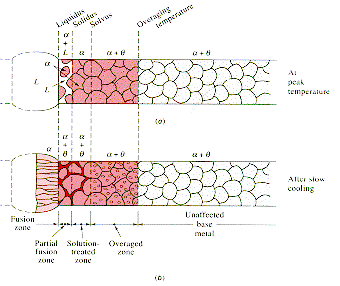| |
If the
material being welded is a precipitation hardened aluminum-copper alloy, the
heat affected zone close to the weld melt region will be raised above the overageing
temperature. The top diagram shows the location of temperature boundaries
associated with the phase diagram and the ageing process. Below the liquidus
temperature the material will be two phases a + L, between the solidus
and solvus temperature the stable material is a polycrystalline a-phase, and
below the solvus temperature a + q phases are present. The lower diagram shows
the weld after slow cooling to room temperature. In this slow cooling process,
the q-phase is precipitated on the a-grain boundaries in the region
that reached temperatures between the liquidus and solvus lines. This will make
this region more brittle. In the zone between the solvus and overageing
temperatures, the material will have a lower yield stress and tensile stress
than the starting plates and this region will be more ductile. Post-weld heat
treatment may be used to correct these effects if the material is cooled into
the single phase a-zone and then cooled in a controlled way. This may not
be practicable. |
|
|
|
|
|
|
|
|
|
|
|
|
